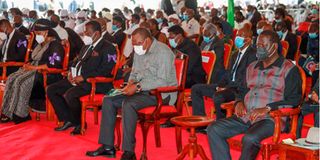Reader’s guide on live TV coverage of political campaigns and funerals

President Uhuru Kenyatta with Musalia Mudavadi and his family during the funeral service of Mama Hannah Atsianzale Mudavadi at Mululu Village in Vihiga County. Also present was former PM Raila Odinga (right).
What you need to know:
- Live TV coverage of political rallies occurs in real-time, as events happen.
- For live TV coverage, the only ‘editing’ done is in the camera movements.
Televised funerals in Kenya can become campaign platforms, sending hot political messages far and wide. We were dramatically reminded of this phenomenon during the funeral of Mama Hannah, Musalia Mudavadi’s mother, on January 9, last year, where some loudmouthed politicians urged President Uhuru Kenyatta to “crack the whip”.
And the President talked tough on BBI and suggested the next president should come from outside the Kikuyu-Kalenjin hegemony. The funeral was covered live on television from Mululu village, Vihiga County. It might as well have been a political campaign rally at Bukhungu Stadium in Kakamega.
Live TV coverage of political rallies occurs in real-time, as events happen. However, it should not be mistaken for streaming, a method of delivering content through the internet. Nor with breaking news, which a TV station decides is too important to wait to be broadcast at the regular news time.
But both live coverage and breaking news require the disruption of normal programing. Commercials and regular programmes are dropped to create the required airtime.
Sponsored content
For live TV coverage, the only ‘editing’ done is in the camera movements. That includes tilting or rotating the camera from side to side to show a particular view, zooming to create dynamic effects, panning to capture a panoramic view and other movements to enhance the viewer’s experience.
Politicians love the free rein that live coverage gives them. They can say whatever they want and speak for as long as they want — without the mediation or intervention of journalists and editors. But viewers can be deceived that live coverage is normal news programming, that what they are getting has been vetted and is legitimate news.
TV stations can guard against such deception by labelling the coverage as “Live” or “Happening now”. But they should go further and indicate whether it is a paid advertisement. If it is, the screen should flash warnings that the content is “Sponsored content” or “Advertiser’s announcement”. Unfortunately, they rarely do that. In the January 23 live coverage of Mr Mudavadi's “earthquake announcement” at Bomas of Kenya, only NTV indicated that it was paid advertising.
Live coverage of political meetings or funerals happen in two situations. The first and most common is when the campaign organisers or bereaved family pay for the airtime (or the TV station donates coverage). The other is when editors decide the event is so significant and newsworthy that it can’t wait for the normal news time to be broadcast.
NMG's guiding principle
In either of those, a cost-benefit analysis is usually done: Is the live coverage cost-effective? If the station will get paid more for the live coverage than it would receive from broadcasting the scheduled commercials and programmes, then the decision might be easy. Otherwise, the decision to cover or not to cover live is not easy or unanimous. It’s not surprising, therefore, to see one TV station cover an event live while another does not.
NMG has a guiding principle. “Live coverage is an editorial tool whose use should be determined solely by the significance of a news event and should never be instigated by the news budget,” states its editorial policy.
If Raila Odinga or Deputy President William Ruto, for example, requests NTV to cover live his campaign rally, the editors might think live coverage is not warranted by the significance of the event. The request is then considered “in the same way as paid advertising”. Even then, the material would — or should — be broadcast, on a time delay of one minute to allow for editing out of content that could violate NMG’s editorial policy guidelines.
NTV is also required to ensure that, in broadcasting the rally live, its viewers would not be deceived that it is “genuine editorial content”. Therefore, the broadcast must be clearly identified and labelled as branded or sponsored advertising. And the live coverage should be kept “totally separate” from news programming and should not look like normal news programming. “It should be clear to the audience who has paid for the airtime.”
The Public Editor is an independent news ombudsman who handles readers’ complaints on editorial matters including accuracy and journalistic standards. Email: [email protected]. Call or text 0721989264.





